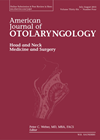
Journal Reviews
The push towards scarless parotid surgery
When dealing with benign parotid pathology, high expectations are placed on the operating surgeon to preserve key neurovascular structures, especially the animating facial nerve, through meticulous dissection. With time, there has been a greater emphasis on improving cosmesis in parotid...
Non-surgical and surgical management of arytenoids granuloma
Arytenoid granulomas are often a sequelae of laryngopharyngeal reflux (LPR). Unless there is suspicion of malignancy, they require a very balanced approach between conservative management and surgical intervention. The authors present a series of 62 patients with whom the primary...
Coblation for laryngeal granulomas
Laryngeal granulomas remain notorious for their tendency to recur after surgical removal. Although high rates of complete remission have been reported with use of the potassium-titanyl-phosphate (KTP) laser, this equipment is expensive and not available in all units performing ENT...
A more comprehensive management for eosinophilic chronic rhinosinusitis after FESS
In recent years there has been increasing recognition of eosinophilic chronic rhinosinusitis which, in particular, results in persistent symptoms and recurrence of nasal polyps, even after FESS surgery. It therefore calls for measures adjuvant to FESS to stop persistence of...
Is canal wall down with obliteration a useful compromise between canal wall up procedure and open mastoid cavities?
Controversy has raged for many years between open mastoid cavity procedures and canal wall up techniques in terms of postoperative recidivism and ear discharge. It is generally believed that canal wall up procedures can miss hidden cholesteatoma but preserve useful...
Salvage surgery vs. repeat stereotactic radiosurgery for progressing vestibular schwannomas
This large multicentre case series of patients treated twice with stereotactic radiosurgery (SRS) for progressing vestibular schwannomas (VS) is reported by the International Gamma Knife Radiosurgery consortium. Progression of tumour growth after primary SRS is rare but does occur. Complications...
DIY Epley manoeuvre
This is an interesting paper that looks at getting patients to do their own particle repositioning manoeuvre (PRM) after having it done by a clinician (‘Epley’ to you and me although there are some slight differences) once a week for...
Playing hide and seek with parathyroid glands
This article focuses on revision surgery with respect to parathyroid glands. Clearly the stakes are higher with respect to the patients’ risks, but also with respect to the revision surgeon in finding the offending gland in scar tissue, where someone...
Treating keloid scarring with pressure clips following excision: does it work?
Keloid scars can pose a difficult management problem. Whilst not harmful in themselves they can be cosmetically unappealing and lead to social embarrassment and resulting isolation, and following surgical excision they often reoccur. Mechanical pressure is an adjuvant to surgical...














